| 1 | Japan’s most common snake |
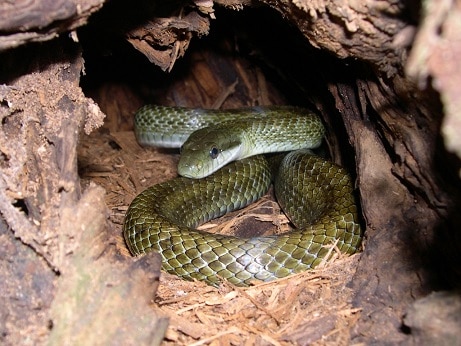
The largest snake in Japan is the Hime Habu, a pitviper in the southern islands of Ryukyu which can grow to 3 metres. However, the longest snake on Honshu and Hokkaido, the two main islands of Japan, is the Japanese ratsnake, also known as Elaphe climacophora.
This snake is a non-venomous and measures 1-1.8 metres on average. They’re born at 40 centimetres long, and after 90 days they usually reach 46cm. By 15 months they’re 75cm long, and by 27 months they’re typically 120cm long. After 39 months, they finally attain the grand length of 140cm.
This species has a natural variety in colours, with the main version being grey with hints of mud, with occasional brown speckles that also have a hint of mud. But there’s also a green-yellow morph, and younglings are completely different; they have beige-brown stripes coiling around their body, which are believed to mimic the venomous mamushi snake. The Japanese ratsnake’s body is long and thin, and they have several nicknames in Japan, including blue general and aodaishō.
| 2 | Occupies most habitats |
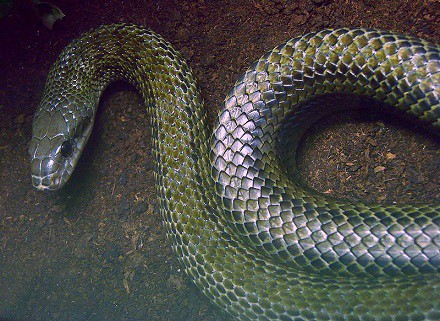
The Japanese ratsnake isn’t close to endangered and is found all over Japan. They occur on Honshu and Hokkaido, but also the scattered Kuril island chain, the former ice age peninsula that once connected Japan to Russia. Japanese ratsnakes can lurk in almost any habitat, including forests, fields, hills, marshes and in trees. They show up in urban areas quite commonly, including the spaces in the ceilings of houses. They also take shelter in old barns, and can be found at almost any altitude, from sea level to 2000 metres up a steep mountain.
Japanese ratsnakes are far more flexible than the venomous mamushi, which prefers to hide in leaf litter in forests. Their one fear is temperature fluctuations, and scientists deduced through fossil excavations that its numbers in northern Japan fell sharply through the last ice. Hokkaido is a cold and snowy place even today, and the ocean channel between Honshu and Hokkaido is extremely narrow and deep, meaning that there was no ice age land bridge to escape over. The ratsnakes were stuck, but despite the extreme pressure of cold, the ratsnake just managed to survive the ice age, and lives in Hokkaido today.
| 3 | The snowy white subpopulation |
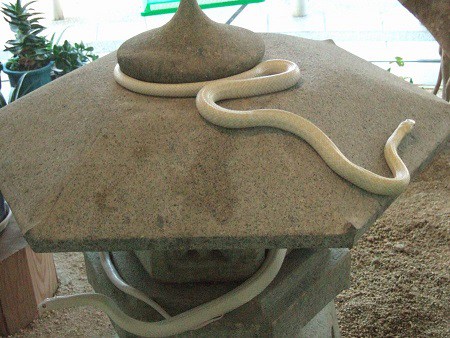
In Japan, snake folklore is embedded in many traditional villages, from protective forest serpents to obscure shrines on the slopes of mountains. The Japanese ratsnake has a large albino subpopulation in Ikwada province (South Japan), which inspired one of the most revered snake spirits of all.
These snakes are a pure white with ruby red eyes, and in 1925, their population was estimated to be 1000. They used to hang around rice fields devouring the rats and mice, and the grateful farmers believed them to be representatives of Benzaiten, the benevolent Buddhist goddess, and bringers of fortune. They dubbed them shirohebi, with the first ever historical reference coming in 1738 when a shirohebi approached a well-fortified castle in Iwakuni.
In 1972, albino ratsnakes were designated as a National Monument of Japan, but urbanisation caused their numbers to fall significantly from 1970 to 1990, as did a fall in the number of rats. Therefore, six breeding facilities were established, and in 2012 this was complimented by a shrine to this scared white snake in Iwakuki, which is now a popular tourist attraction.
| 4 | Shirohebi ratsnake shrine |
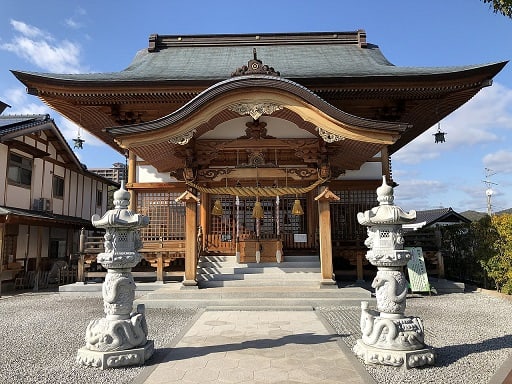
The shirohebi shrine has architecture in the classic Japanese style, with the exception that figures of the albino ratsnake are hidden everywhere. In the main shrine hall there are Toku lanterns to provide illumination, and the bases of these figures are embedded with stone carvings, which are faithful reproductions down to the red eyes and thin body.
Before making an offering at the shrine, all visitors must purify themselves by washing their hands in a chozuya. This well is carved in the shape of a shirohebi, with the water spraying from its open mouth. The gift shop has numerous snake souvenirs for sale, with some containing the real dried skin of an albino Japanese ratsnake. The shop sells numerous omikuji, slips of paper which reveal your fortune, and these are folded into the shape of albino snakes, placed in rows on the wall with their red tongues sticking out and their red eyes glowing.
The main tourist attraction is the shrine is the viewing centre, but there’s also a closed doors breeding facility, where 4000 shirohebi are cared for until the age of 3. This rescue program seems to be succeeding, as in 2005, there were 953 albino Japanese ratsnakes surviving in the wild.
| 5 | Swallows bird eggs whole |
The Japanese ratsnake can eat most animal families, but its focus is warm-blooded prey: mammals and nesting birds. However, it’s also been known since the 1940s to swallow eggs whole.
Firstly, the snake examines the egg and waggles its tongue around, using olfaction to positively identify the food. In stage 2, the Japanese ratsnake seizes the egg in its mouth, before rearranging its jaws laboriously to angle the egg correctly for swallowing. The species doesn’t seem too bright, as they never skip this hassle by placing the initial bite in the optimal spot.
They then swallow the egg whole, leaving a giant round bulge about 6-8 inches from their mouth. The snake rearranges its body into two S-shaped coils, before applying huge pressure to this bulge. The egg inside yields and yields until it finally breaks under the massive pressure, and with the Japanese ratsnake this usually makes an audible crack. For some reason, it’s very difficult for this species to swallow eggs on smooth surfaces. They usually only succeed when they press the round bulge up against a rock or tree.
| 6 | Crushes eggs with its spine |

Egg-eating snakes in the Dasypeltis family usually regurgitate the whole shell instantly. With the Japanese ratsnake things happen differently, as they only regurgitate fragments of the shell beginning at 4 days. But the two species share a special feature for breaking the eggs: hypapophyses attached to their spinal column. These are sharp spikes jutting from the vertebrae, which are found in all vertebrates (including us) but significantly longer and sharper in these egg-eating snakes. When pressed against these spikes, encouraged by the s-shaped coils, the time of the fragile bird egg can be counted in seconds. The shell is pierced on all sides, causing the golden yolk to leak out into the snake’s stomach.
The older the snake, the longer and sharper its hypapophyses, which means that young Japanese ratsnakes are unable to eat eggs. Even the osphagus is a different shape, with loose folds that the hypophyses can slot into instead of puncturing it.
One study found that the Japanese ratsnake took 20 minutes to eat and break the first egg it was given, which fell to 7 minutes with subsequent eggs.
| 7 | How birds are smartening up |
The birds of Japan don’t simply roll over and let the ratsnake eat them or their eggs, as they’ve evolved defences of their own. Japanese great tits (parus major minor) are so intelligent that they have their own language. They don’t just make squawks to send a basic message, but use compositional syntax combined with meanings which are comparable to human talking.
One of their “sentences” draws nearby great tits to them, while another alerts nearby great tits to predators. It turns out that great tits make a specific warning sound when the Japanese ratsnake approaches. Instead of the “chicka” sound they make for forests crows (another egg predator) the great tits make a “jar ” sound. These sounds cause different reactions in the nearby species members. When they hear “chicka”, they examine the horizon, but after hearing “jar”, they scan the ground. This parallels the two species’ strategies, as the ratsnake is forced to approach a tree on the ground first.
When the bird back up crew finally arrives, they join forces and use the antipredator strategy of “mobbing”. They swarm the ratsnake all at once, to increase the costs of attack past the benefits in the snake’s own analysis.
| 8 | How chipmunks are smartening up |
Chipmunks also have specific defences against Japanese ratsnakes, specifically the Siberian chipmunk. This species co-exists with the ratsnake in Hokkaido, the second largest Japanese island, and the Kuril peninsula stretching towards Russia. When scientists placed a snake head in the corner of a box containing 2 Siberian chipmunks, it took a chipmunk a few minutes to notice it gazing at them. But when it did notice, it began mobbing the snake instantly, and soon after the fellow chipmunk arrived, sustaining the assault.
The time it took for chipmunk 2 to arrive was steady, showing that signals were passing between them. Chipmunks also rub themselves in the ratsnake’s scent, to draw other ratsnakes off the trail. Scientists artificially wounded a ratsnake, and when the Siberian chipmunk approached, it nibbled on the grass immediately below the wound site.
In other cases, the chipmunk will find a ratsnake carcass, nibble on a piece of the flesh, and release the chewed results all over its body, sometimes in such high amounts that its fur becomes wet and matted.
| 9 | Now helping Fukushima scientists |
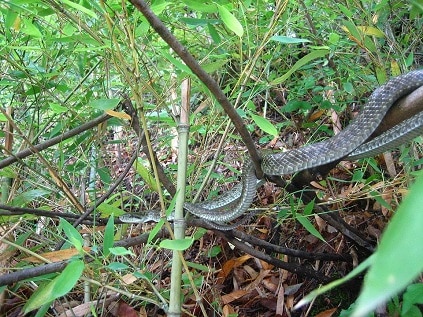
2021 marked ten years since a tidalwave crashed into the Fukushima nuclear facility, causing a catastrophic meltdown which led to a 10 mile radius being completely evacuated. Scientists are constantly monitoring radiation levels nearby, and in 2021, they enlisted the aid of the Japanese ratsnake.
They lured the snake in and wrapped a length of tape around the mid-section on their backs, before supergluing on a GPS or VHF tracker. They let them go free, and after 1 month, they tracked each snake down using the signal and examined their levels of radiocesium, a radioactive isotope. Wild boars and racoons also live in the infected area, but the ratsnakes were deemed to be perfect because of their close contact with the soil, both above and under it.
The scientists studied snakes in 1718 locations, in the Abukama Highlands approximately 15 miles northwest of Fukushima. They spent weeks darting through abandoned villages and farms, in scenes worthy of a zombie apocalypse. The scientists intended to keep monitoring the ratsnakes, and deduce whether the radiation was falling as quickly as the isotope’s half life would suggest.
| 10 | Travels 65 metres each day |
The Fukushima study revealed several bonus facts, such as that the Japanese ratsnake is an active snake species and travels 65 metres per day on average. That far exceeds the pygmy rattlesnake of the southeast US, where one monitored male travelled just 9 metres in an entire year, with even a more energetic one travelling only 227 metres. Again, it’s all down to the ratsnake’s flexibility. The Fukushima study shed some more light on their habits, as the tracked snakes spent a lot of time in deciduous forests, along forest edges, and inside barns, but very little time inside conifer forests.
The Japanese ratsnake is an egg-laying species rather than baring live young, and produces a fairly average amount at 7-20. This is slightly less than the eastern ratsnake of the US (5-27), but more than most rattlesnakes (which produce live young). The timber rattlesnake clocks in at 6-10 while the tiger rattlesnake produces 4-6. It’s also far more than the mamushi, Japan’s most venomous snake species, which gives birth to 2-9 young. Mother Japanese ratsnakes aren’t known to be caring, and abandon their babies immediately after hatching.
